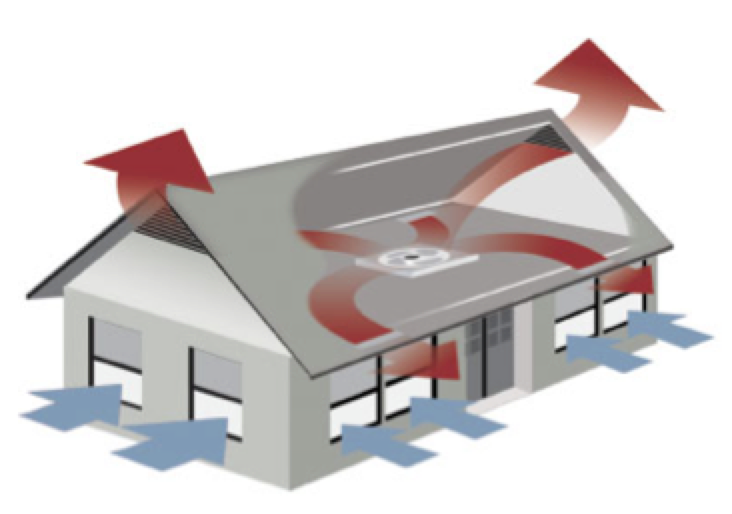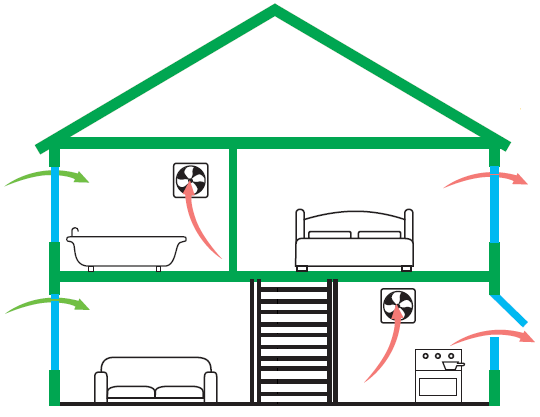Recognizing the Value of Home Ventilation for a Healthier Living Environment
Home air flow plays a vital role in preserving a healthy and balanced living atmosphere. It facilitates the exchange of indoor and exterior air, which is crucial for enhancing air top quality. Without appropriate ventilation, homes can come to be reproducing grounds for pollutants and irritants. The repercussions of poor air blood circulation can be significant. This raises the inquiry of how house owners can properly apply air flow techniques to secure their wellness and well-being. Comprehending these approaches is critical.

The Basics of Home Air Flow
Home ventilation acts as an essential part of indoor air quality and convenience. It includes the process of exchanging stagnant indoor air with fresh exterior air, thereby decreasing moisture and controlling temperature level. Appropriate ventilation systems can consist of all-natural approaches, such as open windows and vents, as well as mechanical systems, such as exhaust followers and air exchangers. Reliable home ventilation assists protect against problems like interior mold development and the accumulation of hazardous particles. It additionally boosts total power effectiveness, as well-ventilated rooms can maintain comfy temperatures with less reliance on home heating and cooling down systems. Comprehending the fundamentals of home air flow is vital for house owners looking for to create a healthier living setting for themselves and their family members.

Common Sources of Indoor Air Pollution

Although lots of may not understand it, indoor air pollution can originate from various sources within a family. Common contributors consist of unstable natural compounds (VOCs) released from paints, solvents, and cleansing items. Family home appliances, such as gas ranges and fireplaces, can release dangerous gases like carbon monoxide and nitrogen dioxide. Furthermore, mold and mold thrive in moist areas, launching spores that impact air high quality. Pet dog dander, allergen, and plant pollen can gather inside, additional worsening air pollution levels. Smoking cigarettes inside generates hazardous chemicals that remain airborne. Finally, constructing materials, consisting of asbestos and formaldehyde, can off-gas hazardous materials. Recognizing these resources is important for maintaining a healthier interior environment and advertising effective ventilation methods.
Wellness Impacts of Poor Ventilation
Indoor air contamination can have substantial health and wellness implications, especially when air flow is poor. Poor air flow can cause the accumulation of harmful pollutants, such as volatile natural substances, mold, and particle matter. This accumulation might result in respiratory system issues, including bronchial asthma, allergic reactions, and chronic obstructive lung disease. Individuals might experience signs and symptoms like frustrations, tiredness, and inflammation of the eyes, nose, and throat. Susceptible populations, such as kids and the senior, are at greater risk for extreme health results. Long-term direct exposure to badly ventilated atmospheres can additionally contribute to a lot more major problems, including cardiovascular diseases. Ensuring correct air flow is necessary for maintaining a healthy and balanced living environment and reducing the threat of health problems linked with indoor air contamination.
Effective Air Flow Approaches for Your Home
Appropriate ventilation is necessary for preserving a healthy interior environment, and carrying out efficient methods can greatly boost air high quality. House owners can start by making certain that exhaust followers are mounted in cooking areas and bathrooms to eliminate excess wetness and smells. Opening up windows regularly enables fresh air to distribute, particularly throughout mild climate. Furthermore, making use of air cleansers with HEPA filters can assist record airborne pollutants. For homes with heating and cooling down systems, preserving cooling and heating systems and transforming filters on a regular basis is crucial for peak performance. Integrating all-natural ventilation techniques, such as cross-ventilation, can likewise improve air movement. Ultimately, sealing any type of leaks in doors and home windows prevents unwanted drafts, which can interrupt regulated air movement, inevitably resulting in improved indoor air top quality and convenience.
Maintaining Optimal Air High Quality Year-Round
To maintain excellent air top quality year-round, property owners should embrace a proactive strategy to managing their indoor atmosphere. Routinely monitoring indoor air top quality is important; this consists of checking for pollutants such as dust, mold and mildew, and unpredictable organic compounds (VOCs) Applying effective air flow systems, such as exhaust fans and air cleansers, can substantially decrease air-borne impurities. In addition, regular maintenance of cooling and heating systems guarantees peak performance and air blood circulation. Homeowners ought to also think about humidity degrees, as too much moisture can bring about mold and mildew development. Seasonal modifications may require changes in ventilation approaches to suit varying exterior air high quality. By focusing on these methods, home owners can develop a healthier space, promoting overall health for all passengers throughout the year.
Frequently Asked Inquiries
Exactly How Can I Tell if My Home Requirements Better Air Flow?
To figure out if a home needs better air flow, one ought to observe indicators such as consistent humidity, mold and mildew growth, musty smells, condensation on windows, or increased allergic reaction signs, indicating inadequate air look at here movement and possibly inadequate interior air high quality.
What Are the Signs of Poor Indoor Air High Quality?

Can Houseplants Improve Indoor Air Quality Properly?
The performance of houseplants in enhancing indoor air quality is questioned. While some research studies recommend they can soak up toxins and generate oxygen, their general impact might be very little contrasted to appropriate air flow and air purification systems.
Just how Typically Should I Modification My Air Filters?
The frequency of air filter changes typically relies on usage and filter kind. Typically, it is advised to replace filters every 3 months, though homes with allergic reactions or animals might need even more regular changes for optimal efficiency.
Exist Any Certain Air Flow Systems for Allergy Sufferers?
Lots of air flow systems, such as HEPA-filtered systems, effectively lower irritants in the air. Home Ventilation Melbourne. These systems catch pet dog, dirt, and plant pollen dander, providing allergy sufferers with a cleaner, healthier indoor atmosphere while handling air high quality successfully
It facilitates the exchange of outdoor and indoor air, which is vital for improving air top quality. Home air flow serves as a vital component of indoor air top quality and comfort. It includes the procedure of trading stale indoor air with fresh exterior air, thereby minimizing humidity and managing temperature level. Indoor air contamination can have significant health and wellness implications, especially when air have a peek at these guys flow is inadequate. Appropriate air flow is important for keeping a healthy read what he said indoor atmosphere, and executing effective approaches can greatly boost air top quality.